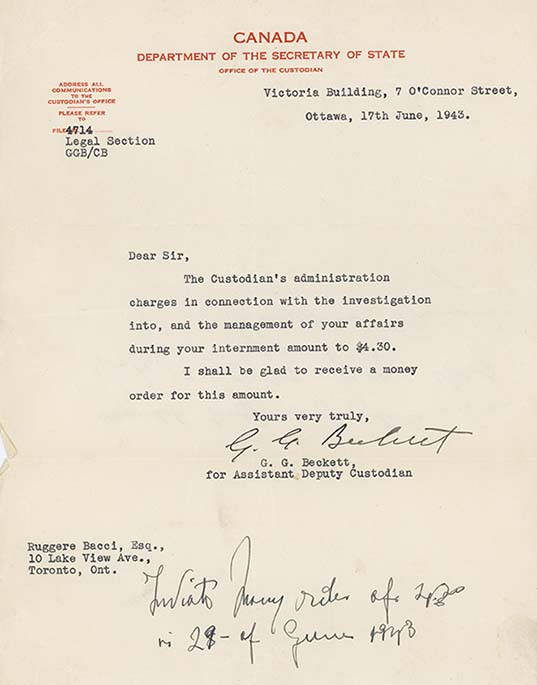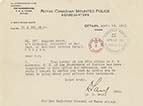Newest
internment, black and white, internee, photograph, document, internment & release, internment operations, petawawa internment camp, letter, internment camp, internees, mail, petawawa, toronto, portrait, camp life, correspondence, ruggero bacci, outdoors, italy,
Popular
black and white, camp, camp life, correspondence, document, family, family life, female, fredericton internment camp, internee, internees, internment, internment & release, internment camp, internment operations, italian canadian, italian canadians, italy, letter, libero sauro,
See all tagsTags
ruggero bacci, return home, mail, letter, internment operations, internment & release, fee, document, custodian of enemy property, correspondence, administration fee
Add each tag separately.
RELATED
Collection objects
Internees
Letter from G.G. Beckett, to Ruggere [sic] Bacci, June 17, 1943
This typewritten letter was sent by G.G. Beckett, for the Assistant Deputy Custodian, to Ruggero Bacci, on July 6, 1943. Bacci had been interned as a security threat to Canada has been recently released; the contents of which center on the CEP fee of $4.30 he was charged for the maintenance of his assets. Bacci did pay the fee -- see LICEA2012-0002-0064. The letter has handwriting in pencil in the lower section noting a money order payment was sent on June 29, 1943. The same information is handwritten on the back of the letter.
The Custodian of Enemy Property (CEP) was a branch of the Canadian government that oversaw the administration of assets belonging to internees and other enemy aliens. This government office served a dual function. Acting as a trustee for the internee/enemy alien, the office and its agents also protected the interests of the creditors. The CEP would pay off an internee’s debts by selling his or her property or businesses. It also collected money owed to internees by others. Each accounting firm hired by the CEP would bill an internee for administrative costs even though internees did not ask for the CEP to be involved. Families of internees often did not have access to the husband's assets and bank accounts. As a result, families often had to negotiate with the CEP for stipends for daily subsistence or use of assets like an automobile. In some cases, where assets were lacking, the CEP divested itself of any interest and left the families to fend for themselves.
Accession#
LICEA2012.0002.0083
Maker
Date
June 17, 1943
Classification
Dimensions
10 x 8 inches
Credit Line
Acquisition Method
Loan
Have something to share?
Add a comment, a picture or share a video. Share with us




















































































